




B. The Ayn, Vast Face, and Small Face
The Ayn
The Mystical Qabalah describes the roots of the Tree of Life as an ultimate,
negatively existent substratum of pure Being that is Self-conscious and
all blissful. It is described as "negatively existent" in relation
to the "positively-existent" four worlds of the Tree of Life.
The three roots of the Tree are named:
Ayn (lit. Nothing; pronounced "ai-n" as in 'nine'),
Ayn Sof (lit. Without End, or Endless; pronounced "sof"
as in 'sofa'), and
Ayn Sof Or (lit. Endless Light, or Light of the Endless; pronounced
"or" as in 'oar').
But these are only distinctions in human thought. The negatively existent
Absolute Being, or shall we say "Mysterious Unknown at the Roots of
All Things," alludes to a depth of consciousness beyond Name and Form,
and beyond the finite and supernal aspects of the Tree of Life. Individual
consciousness cannot usually sustain this experience at length. In fact,
most souls do not return from the experience in the roots. Their shells
of embodied existence (qlifoth) dissolve completely, and they pass
from their physical sheath (i.e. die). In Qabalah, the negatively existent
Absolute Being is also called the "NOT" (Heb. Lo, pronounced
"lo" as in "below").
The experience of the "NOT" finds Its counterpart in every mystical
tradition. The Sufis refer to the experience as fana 'l fana (fana
means "extinction"). The Hindus call it nirvikalpa samadhi.
The Buddhists call it nirvana, sunyata (emptiness), satori,
and anuttara samyak sambodhi (full enlightenment). The Qur'an
refers to the Mysterious Unknown by the same terms used in the Torah.
In Arabic, the word for the NOT is "La": this is written
, which is virtually identical to the Ezra letter Ayin. The shape of the
Sinatic letter Ayin is also suggestive--it is a circle. Within qabalistic
literature, the foundational concept of the negatively existent "NOT"
is most strongly and directly portrayed in the Sifra Detzniyutha
(Book of THAT Which is Concealed). The main body of the text begins:
"The Book of THAT Which is Concealed is the book of the balancing
in weight.
Until NOT (Lo) existed as weight, NOT existed as seeing Face-to-Face.
And the Earth (HaAretz) was nullified,
And the Crowns of the Primordial Kings were found as NOT.
Until the Head (Rosh), desired by all desires,
Formed and communicated the Garments of Splendor.
That weight arises from the place which is NOT Him.
Those who exist as NOT are weighed in YH (Yah).
In His body exists the weight.
NOT unites, and NOT begins.
In YH have they ascended; who NOT are, and are, and will beSifra Detzniyutha 1."
The first chapter of Lao Tze's Tao-Te ChingUnpublished translation opens with verses
that address the Mysterious Unknown and Its two aspects:
"1.1 The Tao that can be trodden is NOT, the enduring and unchanging
Tao. The name that can be named is NOT, the enduring and unchanging
name.
1.2 Conceived of as having no name, It is the originator of Heaven and Earth;
conceived of as having a name, It is the Mother of all things.
1.4 Under these two aspects, It is really the same; but as development takes
place, It receives the different names. Together we call them the Mystery.
Where the Mystery is the deepest is the gate of all that is subtle and wonderful."
Vast Face
In all mystical traditions, the "Mysterious Unknown at the Roots of
All Things" is spoken of as having both inactive (impersonal) and active
(personal aspects). These two aspects are called "Faces" in Qabalah.
When referring to the inactive aspect, represented by the letter Ayin, the
Zohar speaks of "Vast Face""Vast Face": one sees several versions of this appellation arising from differences between Hebrew and Aramaic e.g. "Arikh Anafin," "Arikh Afim." (Arikh Anafin,
also Arikh Afim). It is also known as Al (lit. upon), Shomer
(Witness, Guardian), Atiqa (Hidden One), Supernal Israel, the Ancient
of Days, and other Names found in the Sefer HaShmoth and the
Torah. In the Sefer Yetzirah, the Ayin is alluded
to as the "Organ of Nakedness." "Head" (Rosh),
a word that occurs in the fifth line of the first verse above, is also a
Name of Vast Face. Ayin means "eye," and in the Idra
Rabba Qadusha it says:
"This is the tradition: Were the Eye closed even for one moment, no
thing could subsist. Therefore, It is called the Open Eye, the Holy Eye,
the Excellent Eye, the Eye of Fate (mazal), the Eye which sleeps
not nor slumbers, the Eye which is the Guardian of all things, the Eye which
is the substance of all things."
(Idra Rabba 136,137)
Also,
"And He Himself, the Most Ancient of Ancient Ones, is called Arikh
Anafin, Vast Face, and He who is more external is called Ze'ir Anafin,
or Small Face, in opposition to the Ancient Eternal Holy One, the Holy of
Holy Ones." (Idra Rabba 54)
And,
"The Ancient One is hidden and concealed.
Small Face is manifested and NOT manifested.
The manifested is written in the letters.
The NOT on its level is hidden in the letters,
And He (Hu), the NOT, is settled in YH,
The upper ones and the lower ones." (Sifra Detzniyutha
4)
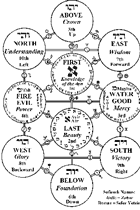 On the Tree, Vast Face is associated with the uppermost center at the crown
of the head called Sefirah Crown/Above. Sefirah Crown/Above is a condition
of Pure Being, a supernal station of superconsciousness that witnesses the
singular modification "I AM" or simply "I." Even this
singular modification disappears in the negatively existent roots of the
Tree. The Sefer Yetzirah teaches that the spheres (Sefiroth)
of the Tree emanate in pairs. Sefirah Crown/Above emanates with its polar
opposite Sefirah Foundation/Below. The tension between these two Sefiroth
manifests the descent of the Central Column of the Tree. The unmanifest
Pure Being of Vast Face in Sefirah Crown/Above is reflected in the abysmal
mirror of Sefirah Foundation/Below as veils of illusion appearing as planes
of existence (see Diagram).
These planes are unmanifest in the most sublime World of Atziluth (Emanation).
The attributes of the Ayn are reflected in this mirror as the immense
I-ness of Small Face as the Creator, Sustainer, and Destroyer of the universe.
These attributes appear as finite in the consciousness of the embodied soul
ensnared in the illusion of separation. The energy of consciousness of Small
Face manifests the planes of existence in the lower three worlds of B'riyah
(Creation), Yetzirah (Formation), and Asiyah (Making, Activity). Like Sefiroth
Crown/Above and Foundation/Below, the two central Sefiroth Knowledge/First
and Beauty/Last emanate as a pair, and represent two opposite stations in
the consciousness of this Small Face I-ness. When the immense I-ness is
centered in Sefirah Knowledge/First, It has the singular awareness that
"I am Nothing;" when centered in Sefirah Beauty/Last that "I
am All." The composition of
the Tree and the four worlds
are discussed in other pages of this site.
On the Tree, Vast Face is associated with the uppermost center at the crown
of the head called Sefirah Crown/Above. Sefirah Crown/Above is a condition
of Pure Being, a supernal station of superconsciousness that witnesses the
singular modification "I AM" or simply "I." Even this
singular modification disappears in the negatively existent roots of the
Tree. The Sefer Yetzirah teaches that the spheres (Sefiroth)
of the Tree emanate in pairs. Sefirah Crown/Above emanates with its polar
opposite Sefirah Foundation/Below. The tension between these two Sefiroth
manifests the descent of the Central Column of the Tree. The unmanifest
Pure Being of Vast Face in Sefirah Crown/Above is reflected in the abysmal
mirror of Sefirah Foundation/Below as veils of illusion appearing as planes
of existence (see Diagram).
These planes are unmanifest in the most sublime World of Atziluth (Emanation).
The attributes of the Ayn are reflected in this mirror as the immense
I-ness of Small Face as the Creator, Sustainer, and Destroyer of the universe.
These attributes appear as finite in the consciousness of the embodied soul
ensnared in the illusion of separation. The energy of consciousness of Small
Face manifests the planes of existence in the lower three worlds of B'riyah
(Creation), Yetzirah (Formation), and Asiyah (Making, Activity). Like Sefiroth
Crown/Above and Foundation/Below, the two central Sefiroth Knowledge/First
and Beauty/Last emanate as a pair, and represent two opposite stations in
the consciousness of this Small Face I-ness. When the immense I-ness is
centered in Sefirah Knowledge/First, It has the singular awareness that
"I am Nothing;" when centered in Sefirah Beauty/Last that "I
am All." The composition of
the Tree and the four worlds
are discussed in other pages of this site.
Small Face
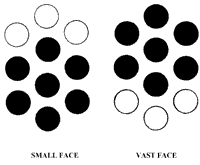 When referring to the active aspect of the NOT (Lo), the Zohar
speaks of "Small Face" (Ze'ir Anafin, also Ze'ir Afim),
represented by the letter Alef. Small Face is the power of the Ayn
to superimpose billions of illusory universes (and their apparent sustenance
and dissolution over time) upon the Vast Face of the Deep. The generation
of universes is brought about by the balanced tension between Vast and Small
Face, or between the Ayin and the manifest Alef of Unity. In the Sifra
Detzniyutha, this tension in the Tree is called "weight"
and the "balancing in weight." The relationship between Vast and
Small Face is depicted in the Tree of Life ( see
Diagram). Some of the most important Names of Small Face are YHVH
, El (pronounced "ale," opposite of Lo), and Adonai
(Lord, Master).
When referring to the active aspect of the NOT (Lo), the Zohar
speaks of "Small Face" (Ze'ir Anafin, also Ze'ir Afim),
represented by the letter Alef. Small Face is the power of the Ayn
to superimpose billions of illusory universes (and their apparent sustenance
and dissolution over time) upon the Vast Face of the Deep. The generation
of universes is brought about by the balanced tension between Vast and Small
Face, or between the Ayin and the manifest Alef of Unity. In the Sifra
Detzniyutha, this tension in the Tree is called "weight"
and the "balancing in weight." The relationship between Vast and
Small Face is depicted in the Tree of Life ( see
Diagram). Some of the most important Names of Small Face are YHVH
, El (pronounced "ale," opposite of Lo), and Adonai
(Lord, Master).
Each universe has its own Small Face who-like a dreamer who knows he/she
is dreaming-creates, sustains, and dissolves the Creation moment by moment
by moment. Our sense of time is formed by our imperfect perception of the
higher planes of existence. Our hopes for the future and our memories of
a past (also created, sustained, and dissolved moment by moment) instill
the impression that time is onflowing. To access the consciousness of Vast
Face, one must renounce Small Face (in whose dream you are a creature) for
release from the dream universe. Hence, it is "only through the Son
(Small Face) that one can know the Father (Vast Face)."The idea that only Small Face can know Vast Face is a
recurrent theme that takes various forms throughout the world’s mystical traditions. It is certainly prominent in the
Gospels, though frequently misinterpreted by commentators.
Relationship Between Small and Vast Face in the Tree
of Life
The Small Face Alef is known as the "manifest Alef of Unity."
Qabalists (and Sufis and Tantrikas) take the allusion of the alphabet quite
literally, and see the universe as built from combinations and permutations
of the letters that emanate from and return to the Alef of Unity. In Sanskrit,
the Alef of Unity is called the Omkara . The Alef a of Unity/Omkara
has unmanifest (Vast Face) and manifest (Small Face) aspects.
As it is written:
"By the First It created Elohim Eth (i.e. the twenty-two
Hebrew letters in the Upper Worlds) the Heavens and VuhEth (i.e.
the twenty-two letters in the Lower Worlds) the Earth." (Torah
B'reshith 1:1)
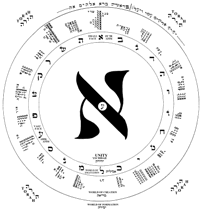
In its unmanifest, inactive aspect in the roots of the Tree, the Alef a
of Unity/Omkara is the undifferentiated source from which emanate
the supernal Hebrew/Sanskrit letters in the uppermost center of the Tree
of Life (Sefirah Crown/Above). At this point, the unmanifest letters stand
alone and have not combined into Names. The letters vibrationally differentiate
when the Alef of Unity becomes manifest in the throat Sefirah Knowledge/First.
Each letter bears a characteristic root vibration or seed sound (Sans. bija).
The Alef of Unity/Omkara is therefore called the "Seed of Seeds"
(Bija of Bijas). Vocalization of the seed sounds is enabled by the
vowels in the throat Sefirah Knowledge/First. The vowels also empower the
undifferentiated Names in the supernal Sefirah Wisdom/East to become manifest
with a characteristic vibrational signature in the World of Creation (see
Diagram).
The Sinatic Alef is written by scribing the vertical line first (Central
Column), from the top point (Sefirah Crown/Above) downwards. Then the horizontal
line is scribed from right to left (Column of the Right). Finally, the diagonal
line is drawn from the left end-point of the horizontal line upward to the
right across the vertical stroke (Column of the Left). The Columns of the
Left and Right are opposite reflections in the clear mirror of the Central
Column. In the Etz HaChayyim (Tree of Life), the vertical
stroke is called the Line of Light (Kav). The Alif in Arabic uses
only this vertical stroke, reflected in the principal Working Tree in the
Sufi tradition that only uses the Central Column. The Cross is the Christian
Alef +, with the diagonal stroke of the Column of the Left removed.
Evolution of the Alef of Unity
The second line of the first verse of the Sifra Detzniyutha
(Book of THAT Which is Concealed) says, "Until NOT (Lo)
existed as weight, NOT existed as seeing Face-to-Face." This is the
condition where Small Face is turned toward Vast FaceIn the Rongo Rongo "Torah" of the Polynesian Kahunas, the condition of Small Face turning inward toward Vast Face is
described as "a jealous flame is Pele’s back," wherein the
Goddess Pele is the active Small Face and Her "back" is Vast
Face. In the Kahuna tradition, Vast Face is further
represented by Pele’s husband "Kamapu’aa" (literally "Pig
Love"). The word for unity in Rongo Rongo is "Eka," which
is identical to that word in Sanskrit. There are a number of
other traditions where the primary form of Small Face is
female i.e. Devi, Kali, Qwan Yin, Isis. and therefore is not
active in manifesting a universe. We find this condition further described:
"And when Ze'ir Anafin looks back upon Him (Arikh Anafin),
all the inferiors are restored in order, and His Countenance is extended
and made more vast at that time. But not for all time is it vast like unto
the countenance of the More Ancient One." (Idra Rabba
55)
The "weight" referred to in the first verse of the Sifra Detzniyutha
is the single combination of all the Sefiroth on the Tree. Weights are the
individual Sefirah. The Primordial Kings allude to the unmanifest "Alef
Worlds" or witness states of Vast Face in Sefirah Crown/Above. The
"Crowns of the Primordial Kings" are the Sefiroth in the supernal
World of Atziluth (Emanation), and the "Garments of Splendor"
are the manifest Sefiroth in the successive three worlds. In the Torah,
"Earth" (Aretz) is a synonym for the Sefirah Malkuth/Kingdom.
Hence, the phrase "And the Earth was nullified" infers that matter
was absorbed and disappeared.
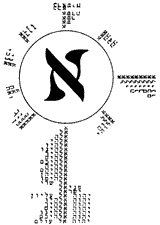 The Sifra Detzniyutha, and in smaller measure the Idra
Rabba Qadusha (Greater Holy Assembly) and Idra Zuta
Qadusha (Lesser Holy Assembly), also contain some wonderful
verses pertaining to the allusions of the "beards" of the two
Faces. The hairs of the beards are the Atziluthic letters convoluting into
Divine Names in the World of Creation. The beards are said to each have
nine formations i.e. strands manifest in Small Face, with four more inside
the Skull of Vast Face as the Hidden Brain. The strands of the Names of
Vast Face (see Diagram) generally
convolute to the Atziluthic letter Ayin, and those of Small Face (see
Diagram), to the Atziluthic letter Alef.
The Sifra Detzniyutha, and in smaller measure the Idra
Rabba Qadusha (Greater Holy Assembly) and Idra Zuta
Qadusha (Lesser Holy Assembly), also contain some wonderful
verses pertaining to the allusions of the "beards" of the two
Faces. The hairs of the beards are the Atziluthic letters convoluting into
Divine Names in the World of Creation. The beards are said to each have
nine formations i.e. strands manifest in Small Face, with four more inside
the Skull of Vast Face as the Hidden Brain. The strands of the Names of
Vast Face (see Diagram) generally
convolute to the Atziluthic letter Ayin, and those of Small Face (see
Diagram), to the Atziluthic letter Alef.
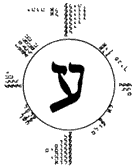 "The Beard of Faith, NOT (al), is mentioned because it is the most
precious of all.
"The Beard of Faith, NOT (al), is mentioned because it is the most
precious of all.
It egresses from the ears round about the face,
The white locks [strands of Names] ascending and descending,
Separating into thirteen of that most splendid of splendors." (Sifra
Detzniyutha 2)
"The formations of the Beard are found to be thirteen,
That is the upper one [Vast Face].
In the lower one [Small Face] they are beheld in nine." (Sifra
Detzniyutha 3)
"Each hair is said to be the breaking of the hidden fountains that
issue forth from the Hidden Brain [Vast Face]." (Idra Rabba 74)
"And all those threads [i.e. convoluting Names] go out from the Hidden
Brain and are disposed in the weights [i.e. Sefiroth]." (Idra
Zuta 63)
Conclusion
In speaking of two "Faces," it must always be remembered that
we are talking about an absolute unity that is only differentiated by human
thought, and can only be directly experienced in higher states of consciousness.
Generally, mystical traditions are very fluid and flexible in assigning
gender to Vast and Small Face. In most mystical traditions, both Vast and
Small Face can take either the masculine or the feminine gender. Within
a particular tradition, one may find Vast Face referred to in the masculine
and Small Face in the feminine, and/or vice versa. The two Faces may also
be both masculine or both feminine. In the Qabalah, for instance, we find
many references to the white-haired ancient father and the raven-haired
youthful king. We also find the ancient mother and the maiden Shekhinah.
In virtually all traditions, we can also find many impersonal names and
references to Vast Face that are neither masculine nor feminine. However,
Small Face, as the active principle, is always named and referred to personally
as masculine and feminine. It is cogent to note that the Torah commands
us to "Honor thy father and thy mother." While this is commonly
understood to refer to one's earthly parents, its higher meaning enjoins
us to honor our Divine Father and Mother.
The great and beloved nineteenth century Bengali saint Sri Ramakrishna Paramahamsa
offered several useful analogies to the relation between Vast and Small
Face (static and active aspects of the Divine). These included the relation
between milk and its whiteness, a gem and its sparkle, a flame and its power
to burn, and the Sun and its raysNikhilananda, Swami, Gospel of Sri Ramakrishna,
Ramakrishna-Vivekananda Center, New York, 1973.. An old Vedic analogy compares God to
a spider that spins a web from and retrieves it back into its own body.
An analogy in Qabalah cites the relationship between the letters of the
alphabet and the vowels: without the vowels (active aspect), the letters
(inactive aspect) cannot be pronounced. In the Tantra, it is said that "without
the vowels, Shiva's bones can't dance."
Another analogy that illustrates the nature and relation of the two Faces
is presented in the parable of the rope and the snake:
"A man was walking down a road in the country at dusk. Just as he turned
a corner, he encountered what appeared to be a large snake. His whole body
gripped with fear, and without thought, he jumped back to avoid getting
bitten. As he looked at the snake, he noticed that it wasn't moving. He
picked up a rock and threw it at the snake, and still the snake didn't move.
He thought, 'Perhaps the snake is dead.' This thought diminished his fear,
and he inched closer to the snake to get a better look. As he neared the
snake, he was amazed and relieved to find out that it wasn't in fact a snake
at all: it was a rope that he mistook for a snake."
In this story, there had to be a rope in the first place for the man to
have mistaken it for a snake. The "snakiness" was a superimposition
upon the rope that only existed in the man's mind. Such is the nature of
the Creation, which is a collective illusion. The "snakiness"
of Small Face is an illusion superimposed upon the reality of the "rope"
of Vast Face. This illusion of a "difference within Itself" is
a play of the Divine arising from an unfathomable whim.